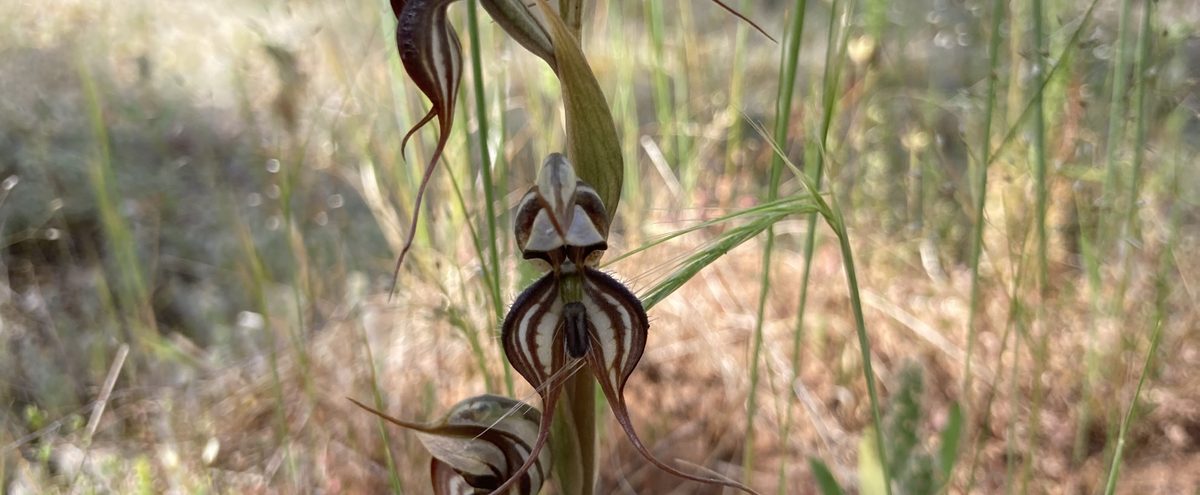
Sandhill greenhood orchid
The sandhill greenhood orchid (Pterostylis arenicola) is listed as nationally vulnerable with an estimated 100,000 plants left in the Murraylands and Riverland region. Landscape board ecologists are working with the community to conserve the remaining sandhill greenhood orchid through monitoring and supporting landholders with known clusters of plants.
What is a sandhill greenhood orchid?
The sandhill greenhood orchid is a solitary herb with flowering stems that extend to 25 cm tall as the flowers develop. Plants can have one to ten flowers with ‘hoods’ that are green and brown or red-brown with white markings. They also have a tuberous roots system and several leaves which form a flat basal rosette on the ground. Rosettes often begin to die down by the time of flowering.
The sandhill greenhood orchid can be found in mallee and native pine woodlands, flowering as early as August, but often from September until the middle of spring. Like most orchids, they will only flower for a short period, usually a matter of weeks. Seeds mature between November and December, and plants become dormant from end of December after seeds have set, until June of the following year.
Where are sandhill greenhood orchids found?
In the Murraylands and Riverland region, the sandhill greenhood orchid is found near Tailem bend, Meningie, the Coorong and Narrung Peninsula. This species can generally be found on sloping or undulating sites on sand and sandy loam soils, and in areas with mild winters and warm to hot summers.

Why are sandhill greenhood orchids under threat?
Sandhill greenhood orchids are under threat from grazing by overabundant native animals such as kangaroos, livestock and feral herbivores. Soil disturbance at some sites from rabbit or kangaroo scratching may be inhibiting regeneration of this species. Populations are also under threat because they are easily smothered by weeds such as bridal creeper, freesia, and perennial veldt grass. Like many native orchids, they are also at risk from illegal plant collection and flower picking.
The sandhill green orchid has a complex reproductive strategy. They require a particular mycorrhizal fungus that must be in the soil for seeds to germinate. In addition, the flowers must be pollinated by a particular type of insect, the fungus gnat. The gnat is attracted by the orchid’s pheromones and tries to mate with the flower. Pollen is dusted on to the gnat, which transfers pollen as it moves from flower to flower.
What is being done to protect sandhill greenhood orchids?
Landscape board ecologists are working with landholders and other agencies to monitor known communities. This work includes regular surveys and undertaking pest control work and weed control work. Some landholders have protected sandhill greenhood orchid populations on their properties by placing them under a Heritage Agreement so the vegetation is conserved in perpetuity.

How you can help!
Some of the ways that you can help preserve native plants include:
- Preventing damage caused by grazing.
- Preventing removal/illegal collection.
- Controlling weeds to reduce competition.
- Taking a photo instead of picking the flower.
- Volunteering with the Murraylands and Riverland Landscape Board or joining your local native vegetation group.
- Reporting any sighting of these endangered plants to our offices
What should I do if I see a sandhill greenhood orchid?
If you are lucky enough to see a sandhill greenhood orchid, the most important thing to remember is to not touch or remove it. Take a photo and be discreet about its location to protect it from illegal collection.
If you suspect you have a population of sandhill greenhood orchid on your property, please contact our ecologist who will help to formally identify the plant. They can offer you support and advice to help conserve and enhance this vulnerable species so you can play a vital role in conserving our unique native biodiversity.